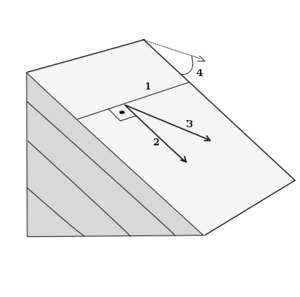Difference between revisions of "Dip"
Jump to navigation
Jump to search
Cwhitehurst (talk | contribs) |
FWhitehurst (talk | contribs) m (added Category:Geological methods using HotCat) |
||
| Line 6: | Line 6: | ||
{{stub}} | {{stub}} | ||
| + | |||
| + | [[Category:Geological methods]] | ||
Revision as of 20:33, 14 April 2014
True dip is the angle between an inclined surface and the horizontal, measured perpendicular to a horizontal line in the plane (strike). The dip seen in a limited data set (well bore, outcrop, cross section, seismic line, etc.) may not be perpendicular but rather cut at an angle, and is the apparent dip; this is less that the true dip. It is usually written as 4S (dipping 4 degrees in the southerly option perpendicular to strike; this requires that a strike be given), 4 SE (likewise), or 4 65SE (dipping 4 degrees in a 65SE direction; this by inference gives the strike, because it is perpendicular).
Figure 1 illustrates the strike and dip of beds.
This article is a stub. You can help AAPG Wiki by expanding it.
